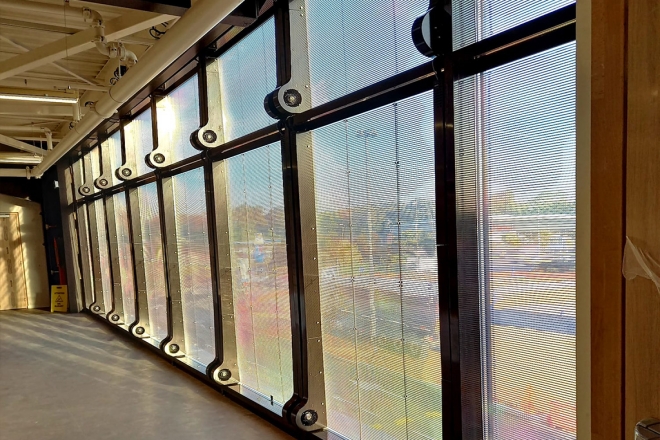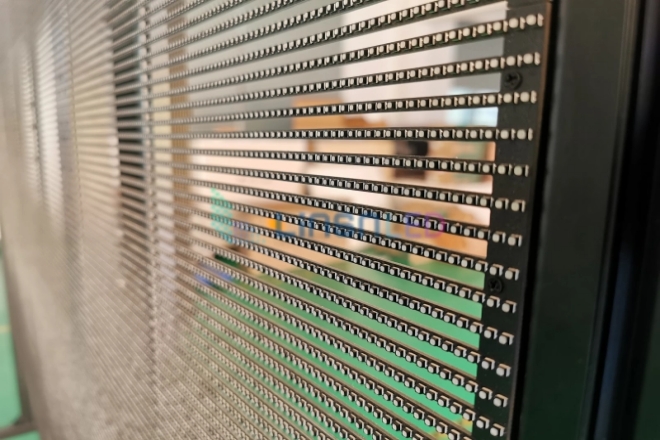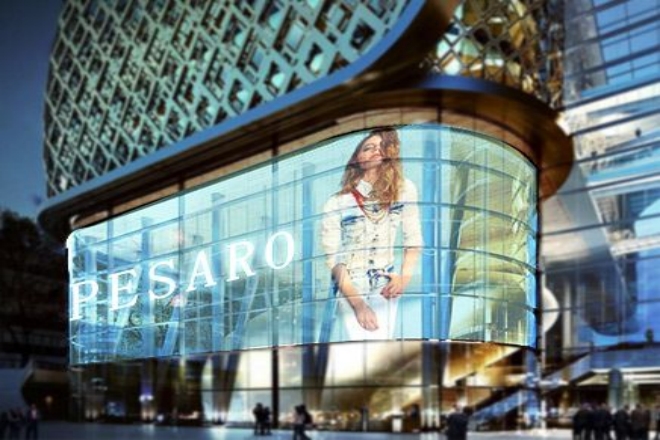Introduction
In today’s era, where vision is king, display technology is developing at an unprecedented speed. Among them, écrans LED transparents have become a bright new star in the fields of commercial display, outdoor advertising, interior decoration, etc., with their unique transparent characteristics and excellent display effects.
Transparent LED displays can not only present images, videos, and other content in high definition but also retain the transparency of the background vision so that viewers can feel the wonderful fusion of the surrounding environment while enjoying the content.
However, facing the dazzling array of transparent LED display products on the market, how to make a wise choice has become the focus of many users.
This article aims to deeply explore the key factors that should be paid attention to when choosing a transparent LED display, so as to help readers find the most suitable products for their needs in the complex market and achieve a perfect balance between vision and function.
1. Transparency and visual effects of transparent LED displays

1). Transparency level
1.1). What is transparency?
Transparency is like a piece of glass, you can see what is behind the glass. The same is true for transparent LED displays, which allow viewers to see the scenery or decorations behind the screen, while playing various images and videos on the screen.
1.2). Different models have different levels of transparency:
Imagine standing in front of two stores, both of which use transparent LED displays, but one looks more “transparent,” and the other is slightly blurry. This is because they have different levels of transparency. Which one you choose depends on how much background you want to see and how clear you want the content on the screen to be.
1.3). Find a balance:
If it is too transparent, the content on the screen may not be bright or vivid enough; if it is not transparent enough, the background will not be visible. So, when choosing, you should consider whether you want to see more of the background or make the content on the screen clearer.
2). Visual effect optimization
2.1). The impact of transparency on the picture:
With high transparency, the colors on the screen may not be as vivid, and the image may appear a little dark. It’s like reading a book in the sun; the words will appear lighter.
2.2). How to make the picture look better?
Brighter lights: Use brighter LED lights, just like turning on a desk lamp when reading at night, to make the picture brighter.
Good design: When designing the screen, find ways to make the light shine better on the screen and reduce waste.
Automatic adjustment: Smart screens will automatically adjust the brightness according to the light outside, brighter during the day and darker at night.
Color management: Ensure the color on the screen is accurate, just like coloring a painting, making the picture more realistic.
Anti-reflection: Add an anti-reflective coating to the screen, just like the anti-reflective film on glasses, to reduce reflections and see more clearly.
In general, when choosing a transparent LED display, think about the effect you want, see which model has the most appropriate transparency, and then use some technical means to make the picture more beautiful. In this way, you can get a display that is both transparent and beautiful!
3). Résolution and pixel density of transparent LED display
3.1). Benefits of high resolution
Clearer images: High resolution is like a high-definition photo. The image on the screen has a lot of details, so small that you can see a strand of hair clearly. This makes the image look more realistic and delicate.
More readable text: If there is text on the screen, high resolution can make the edges of the text very clear. Even if it is a little further away, the text will not become blurred or overlapped, and it is easy to read.
Improve viewing experience: In general, a high-resolution screen can make the audience more comfortable to watch; just like watching a movie with high-definition quality, the experience will be better.
3.2). A little knowledge of pixel density
- What is pixel density?
Pixel density is like the density of “dots” on the screen. The more dots there are, the finer the screen is and the clearer the image is.
- How do you choose the right pixel density?
It depends on where you use the screen and how far away the audience is from the screen. For example, if you put an ad in a shopping mall, people may walk closer to see it, so you need a screen with a higher pixel density to make the image clearer.
But if it is outside a building, people may be farther away, so you can choose a slightly lower pixel density, which can also be seen clearly, and the cost will be lower.
Therefore, when choosing a transparent LED display, you should consider where it will be placed and how far the audience will stand to see it so as to choose the most appropriate resolution and pixel density to make the screen look the best.
2. Brightness and contrast of transparent LED display

1). Luminosité exigences
- The impact of background environment on brightness:
Imagine that you want to display some information on a transparent LED display outdoors on a sunny day.
However, if the screen brightness is not high enough, the sunlight may make the content on the screen blurry and difficult to recognize.
Therefore, when transparent LED displays display content in a background environment, they need to have sufficient brightness to ensure that the content is clearly visible.
- Advantages of high brightness:
High brightness is like adding a “spotlight” to the screen, which can help the screen content stand out in a strong light environment.
Even in direct sunlight, the high-brightness transparent LED display can keep the content clearly visible, effectively offsetting the impact of background lighting. In this way, the audience can easily see the information on the screen at any time and at any place.
2). Contrast enhancement
- The power of contrast:
Contrast is like the “black and white” in the picture, which determines the degree of difference between the brightest and darkest parts of the image. High contrast can make the image outline clearer and the color more vivid, thereby enhancing the clarity and visual impact of the image.
- Present a richer and more vivid picture:
Choosing a transparent LED display with high contrast means that you can present a more colorful, vivid and realistic picture. Whether it is bright colors, deep shadows, or delicate textures, they can be perfectly displayed.
Such a picture can not only attract the audience’s attention, but also make them more immersed in the displayed content and gain a deeper experience.
3. Installation method and adaptability of transparent LED display
1). Diverse installation methods
Transparent LED display is widely used in various scenarios due to its unique transparent characteristics and diverse installation methods. The following are several common installation methods and their advantages, disadvantages, and applicable scenarios:
1.1). Wall-mounted installation
Advantages: easy installation, space-saving, screen, and wall are closely integrated, and the overall sense is strong.
Disadvantages: high requirements for the wall, the wall needs to be flat and able to bear a certain weight.
Applicable scenarios: family living room, small shops, exposition rooms and other places with limited space and flat walls.
1.2). Suspended installation
Advantages: does not occupy ground space, can adjust height and angle as needed, and has strong flexibility.
Disadvantages: high requirements for the suspension structure, need to ensure safety and stability.
Scénarios applicables : centre commercial atrium, exhibition hall, organiser background, and other places that need a high-altitude display.
1.3). Embedded installation
Advantages: the screen is integrated with the surrounding environment, is beautiful and generous, and does not take up extra space.
Disadvantages: difficult to install, need to pre-design the embedded position and size.
Applicable scenarios: places that require high integration, such as building glass curtain walls, window displays, and interior decoration.
1.4). Other installation methods
Ground installation: Suitable for places such as exhibitions and shopping malls that require a large-scale display, and the screen is placed on the ground through brackets or fixtures.
Hanging installation: The screen is installed on the window or glass curtain wall of the building, which is suitable for shops, hôtels, and other places that need to attract the attention of passers-by.
2). Site restrictions and adaptability
When choosing the model and installation method of the transparent LED display, the site restrictions and installation conditions must be fully considered. Here are some key factors:
Site size and shape: Choose the appropriate screen size and installation method according to the size and shape of the site. For example, in a small space, wall-mounted or embedded installation may be more suitable; while in an open space, hanging or ground installation can better display the effect.
Load-bearing capacity: Make sure that the installation location can bear the weight of the display. Especially for hanging and embedded installations, strict load-bearing calculations and safety assessments are required.
Light and temperature conditions: The display effect of the transparent LED display is greatly affected by light and temperature. When choosing the installation location, try to avoid direct sunlight and extreme temperature changes to ensure the stability and display effect of the screen.
Maintenance and repair: Consider whether the installation location is convenient for subsequent maintenance and repair work. For example, for screens installed at high altitudes, it is necessary to ensure that there are safe maintenance channels and repair platforms.
4. Product quality and reliability of transparent LED display screens

1). Pick a good supplier
Buying a transparent LED display screen is like choosing a mobile phone. You have to find a reliable “manufacturer” or “seller”. This “manufacturer” or “seller” must be famous, and everyone says it is good, so the quality of the screen purchased is guaranteed.
Why? Because they have experience, make good screens, and have perfect after-sales service, so if there is a problem, it can be solved in time.
2). The screen must be good and durable
- How to see if the screen is good?
We can look at the actual display effect of the screen, such as whether the color is bright or clear. You can also listen to what other people who have used it say, and their evaluation is very important. Some screens have also passed special tests, just like mobile phones pass quality inspections, so such screens are more reliable.
- What does durable mean?
Durability means that the screen is not easy to break and can be used for a long time. Just like when you buy a car, you hope that it can be driven for a few more years without major repairs.
The same is true for high-quality transparent LED displays. It can withstand various environmental tests, such as sun, wind and rain, and is not easy to have problems.
3). Why is a good quality screen so important?
Save money: A good quality screen is not easy to break, so you don’t need to spend money to repair it frequently, which saves money in the long run.
Worry-free: The screen is always good, so you don’t have to worry about it suddenly “going on strike” and affecting your use or display effect.
Improve the effect: A high-quality screen can show clearer and more vivid pictures, giving the audience a better visual experience so that your display or advertisement is more attractive.
Therefore, when buying a transparent LED display, you must choose a good supplier and a high-quality and durable screen so that you can use it with confidence, worry-free, and save money!
Conclusion
In summary, choosing a transparent LED display is a process of comprehensive consideration of many factors.
From the balance between transparency and visual effects to the fine selection of resolution and pixel density, from the optimization of brightness and contrast to the flexible adjustment of installation methods and adaptability, to the strict control of product quality and reliability, as well as the long-term consideration of energy conservation, environmental protection, and economic benefits, every step is crucial.
Through the discussion in this article, we hope to provide readers with a detailed purchase guide to help everyone make wise decisions among many options.
Enfin, si vous souhaitez en savoir plus sur les écrans d'affichage LED, veuillez nous contacter.
